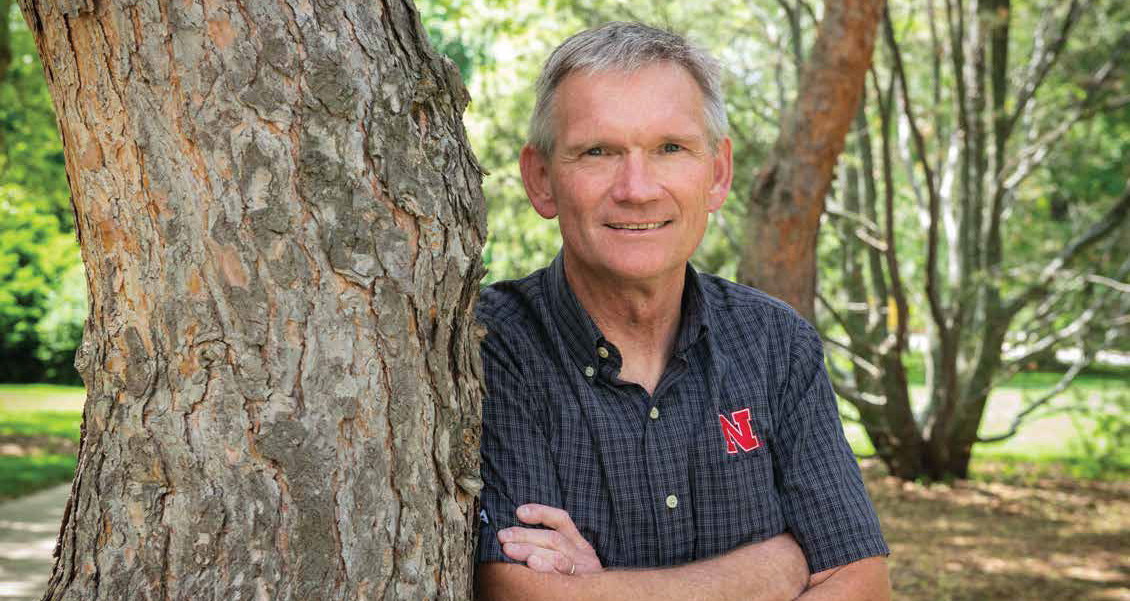
Nebraska's Advantage is Finding a Win-Win
The Resilience of Agricultural Production and Natural Resources Management

Feeding the growing global population by 2050 is a challenge that agricultural professionals around the world are trying to solve. The Institute of Agriculture and Natural Resources (IANR) at the University of Nebraska–Lincoln is dedicated to protecting and sustaining Nebraska’s natural resources, while increasing and improving agricultural production.
Achieving global food security without harming the environment requires agricultural and natural resources professionals from a variety of IANR departments working together, rather than separately, to find solutions.
“You need experts from lots of disciplines working together to try to get answers to the problems that might arise for our society,” said John Carroll, director of the School of Natural Resources (SNR) at the university.
Carroll said that SNR pursues solutions while keeping the environment at the forefront of the conversation. The relationship between Nebraska’s productive agriculture and bountiful natural resources is complex and important. If both systems are not taken into account, ecosystems suffer, natural resources deplete and the environment supporting food production deteriorates, causing agricultural production to decrease.
SNR Research and Education
The ultimate goal of SNR is to make this world a better place while realizing there are boundaries to what we can do to it, Carroll said. Protecting the world’s ecosystems, wildlife and natural resources is critical for the survival of the planet and humanity.
With the support of IANR, SNR approaches global challenges by examining the whole ecosystem and identifying the relationships between agriculture and natural resources, Carroll said. This approach is dependent upon working with various departments across the University of Nebraska system so that both social sciences and physical sciences play a role. It is not enough to just look at climate, plants or animals without taking into account why and how people make the decisions about their environment and their role in that environment.
“Instead of answering a single question about making one part of our society better, we want to answer questions about a range of problems until we really understand how the whole system operates, rather than just how little parts of it operate,” Carroll said.
Leveraging the Land-Grant Model
The University of Nebraska–Lincoln is one of more than 100 land-grant institutions in the United States and its territories, which were established by the passage of the Morrill Act in 1862. The land-grant system formed the framework for the institutional missions of teaching, research and Extension. Twenty-five years after the Morrill Act was passed, Congress passed the Hatch Act in 1887, which established agricultural experiment stations in connection with land-grant colleges so research could be conducted and applied in practice.
Because of this model, the university has a dedication to agriculture, and in this design, IANR facilitates agriculture and natural resources across three pillars of research, teaching and Extension. Many faculty members within SNR focus research across these pillars. One example is tying water quality first to crop health and then to human health.
“Nebraska is one of the most agricultural states in the country,” Carroll said. “Everybody in the School recognizes we’re a very important agricultural state.”
However, more pressure is being put on the state’s natural resources as agricultural production evolves and continues to grow. Even so, Carroll sees the integration of natural resources with agriculture as Nebraska’s opportunity to thrive. Nebraska’s agroecosystems rely on finite natural resources, wildlife and climate to sustain its agricultural production.
“We can’t just live by growing corn alone,” Carroll said. “But, we can grow a lot of corn and do a better job integrating that with other land uses and making it more sustainable for the long term.”
Producing corn — and other agricultural products — requires attention to surrounding ecosystems in order to be sustainable. For example, much of the state is dependent on irrigation to fuel crops, but responsible use of those water resources is necessary to prevent negative impacts on water quality and quantity. SNR helps prioritize this effort to be sustainable and resilient in its work with the other areas of IANR, Carroll said.
If those in agriculture and natural resources do not work together to solve the issues facing us, “then we’re not doing our job,” Carroll said. Both industries need to account for changes that affect the ecosystem whole ― issues like climate change, nitrate runoff, and aquifer use ― that affect future agricultural production and the ability to feed a growing population.
Nebraska’s Advantage
A large network of the state’s most important natural resources centers and units finds a home and support in SNR. These include the Nebraska State Climate Office, the Conservation and Survey Division, the Center for Advanced Land Management Information Technologies and the National Drought Mitigation Center, among others.
“I think a lot of people in the state of Nebraska utilize what we produce,” Carroll said. “But they may not recognize it’s all part of this larger School entity.” These units provide education, research and outreach to all Nebraska citizens — from producers to consumers.
SNR’s reach also extends beyond Nebraska. “We want to make sure we do the best job we can in Nebraska and in the Midwest, but that does not stop us from having a global reach,” Carroll said. This global reach is SNR’s ability to work with other universities and agencies across the world to advance research on the earth’s natural systems.
Under the facilitation of IANR, SNR supports state agencies, nongovernmental organizations and the federal government to better manage the world’s natural resources. Supporting the state’s farmers and private landowners, through Extension and research, is also a central mission for SNR.
Additionally, solving challenges and managing the state’s natural resources is critical to SNR. One part of Nebraska’s natural advantage is its superior system for managing its water. “We can grow crops using irrigation, which allows us to have very good yields compared to lots of other places, without damaging our aquifer resources,” Carroll said, pointing to the Conservation and Survey Division’s groundwater monitoring network that provides Nebraskans up-to-date information on the aquifer supply. When levels dip, communities can respond, curbing use and helping groundwater levels recover.
To ensure that natural resources are available for future generations while also feeding the growing global population, SNR has placed an emphasis on resilience science.
An Interface for the Future
Producing food for the growing global population will put increasing pressure on Nebraska’s ecosystems in the future. As the problems investigated within SNR continue to come to the forefront of agriculture, preparing natural resources professionals to solve them will rise rapidly in importance.
“Luckily for us, I think millennials and the generations coming after them — all of our students now — are quite well suited for studying those problems,” Carroll said. SNR students will have to continue trying to integrate agriculture and natural resources into the future.
In Nebraska, natural resources professionals understand the importance of living in an agricultural state, according to Carroll. Similarly, agricultural producers realize that a focus on crop production without looking at other factors diminishes the opportunity of the agriculture and natural resources interface. It is truly when these two areas integrate and collaborate that the whole state — its agricultural industry, its ecosystems and its people — will thrive.